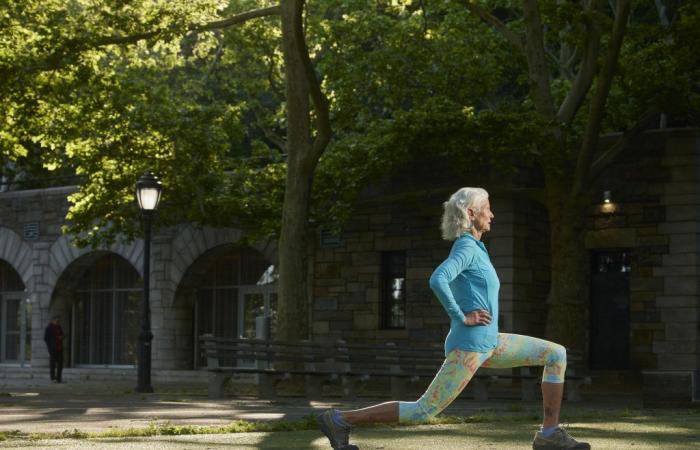When Barbara Hannah Grufferman was in her early 50s, a bone densitometry test showed she was headed for osteoporosis. If she did not change her lifestyle, her bones would become increasingly fragile, which would expose her to a high risk of suffering fractures of the spine, hip and other bones that would affect her life.
Grufferman had always been active: she had run after two daughters and walked her dog around Manhattan. But I hadn’t done much formal exercise. since “the Jane Fonda era” at age 20, he said.
When he found out aboutu low bone density, began training to run the New York Marathon and doing planks and squats daily. He practiced standing on one foot whenever he could to improve his balance. Today, more than 15 years later, his bone density has remained stable and she is training for his 18th marathon.
“I am a living example that it is never too late to act,” Grufferman, 67, said.
But you don’t have to run marathons to protect your bones. Just add some strategic exercises to routine to strengthen them, now and in the future.
“People think of bones as static,” said Dr. Andrea Singer, medical director of the Bone Health and Osteoporosis Foundation. But it’s a living and dynamic organ that is constantly remodeled.
As with muscles, the more stress is strategically placed on bones with exercise, the more they get strongerhe assured.
Stretching. Photo Nicholas Sansone/The New York Times.
The bones of all of us weaken with age, but 80% of Americans with osteoporosis are women, and half of women over 50 they will break a bone because of the disease. Women reach their maximum bone density at age 20. The greatest decline occurs within five to seven years after menopausewhen estrogen levels, which help keep bones strong, plummet.
The sooner you start strengthening your bones, the better, but it is never too late, say the experts. If you’ve already been diagnosed with low bone density, have broken bones in the past, or have osteoporosis, talk to your doctor about the best training plan before starting anything new.
For cardio, gravity is your friend
Although most exercises are good for bones, those that require the body to support its own weight are especially effective at strengthening bones, experts say. This helps explain why astronauts’ bones weaken in space and why they spend two hours a day exercising.
“The bones are very, very adaptable» explained Rebekah Rotstein, Pilates instructor and creator of Buff Bones, a fitness program to help women strengthen bones, who has worked with hospitals across the country. “They respond to external forces by becoming stronger, and a lack of strength weakens them.”
If you’re new to aerobic exercise or just getting back into the swing of things — or if you’ve already been diagnosed with low bone density — start by walking, says Dr. Mary O’Connor, professor emeritus of orthopedics at the Mayo Clinic and chief medical officer. from telehealth company Vori Health. Carrying weights in your hands can also help strengthen the bones in your upper body.
Resistance exercises. Photo Nicholas Sansone/The New York Times.
If you exercise regularly and have not been diagnosed with low bone density, cardiovascular exercises that put more force on the body are ideal for preserving or strengthening bones. Running and jumping exercises (for example, box jumps or jumping jacks) are good options. Exercises that involve moving in multiple directions, such as dance, tennis, or pickleball, are even better.
«Surprise the body with new movements in different directions has a better and more effective effect on bone formation than doing hours and hours of repetitive activity,” said Dr. Kathryn Ackerman, an associate professor of medicine at Harvard Medical School who studies bone health.
If bones are already brittle, high-impact exercises can increase the risk of fracture, “because they put more pressure on the bone,” O’Connor explained. So talk to your doctor about what your body can handle.
The regularity It is also key, since the bones must undergo constant effort to stay strong. Instead of piling on workouts on the weekends, do 30 minutes of weight-bearing cardio a day to maintain bone health.
Muscles to strengthen bones
According to experts, resistance training strengthens the bones as well as the muscles, which in turn strengthen the bones further by exerting a additional strength about them.
“We used to be very concerned about older women in particular and making them do too much” or lift too much weight, Ackerman said. “We did some damage to them because they got nervous when they had to move, because they thought they were going to fracture.”
As part of his Buff Bones program, Rotstein recommends doing squats, hip curls, lunges, calf raises, planks, and push-ups regularly, paying close attention to form, so your joints and bones are properly aligned.
Walking also helps. Photo Nicholas Sansone/The New York Times.
According to Rotstein, these exercises strengthen the muscles essential for everyday activities, such as sit and stand, stoop to lift objects and reach objects from a shelf.
Also consider using free weights or machines, Ackerman said, but start slowly. As we age, these daily activities can lead to fractures if our bones and muscles are not yet strong.
Improve your balance
A complete workout for bone health should also include exercises designed to keep us stable on our feet. This can help prevent falls, which can be especially devastating to bones as you age, Ackerman said.
According to experts, single-leg balance exercises, weight shifting, Pilates and yoga help maintain balance. And research indicates that tai chi can be especially effective.
If you have weak bones, avoid bending and twisting
Finally, if you have already been diagnosed with osteoporosis, avoid movements that involve bending completely forward from the waist and rapid twists. “Most hip fractures in older women with osteoporosis – what we would call fragility hip fractures – occur before a fall,” O’Connor explained. “A person gets up, turns, breaks his hip and falls.”
“The bones are weaker in torsion,” he added.
But don’t let the fear of fracture deter you from moving, he said. With a few precautions, staying active now is what will keep you active for years.
Translation: Elisa Carnelli
➪Do you have any questions about health and well-being that you would like us to address in the section notes? Enter the Clarín Help Center by clicking here, enter Message to the editor and then to Questions to Buena Vida. Write us your query and send. Ready! And if you want to receive the Buena Vida newsletter in your inbox every 15 days, subscribe here.






